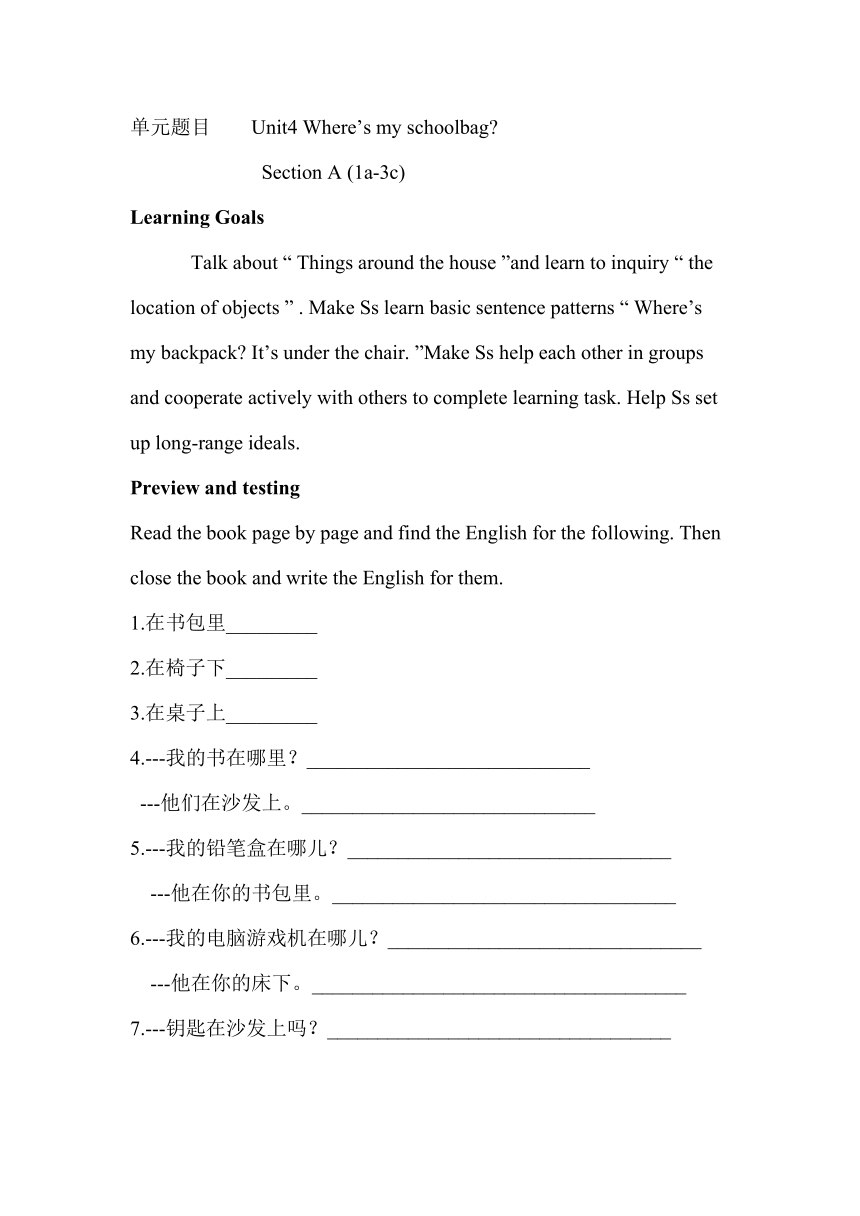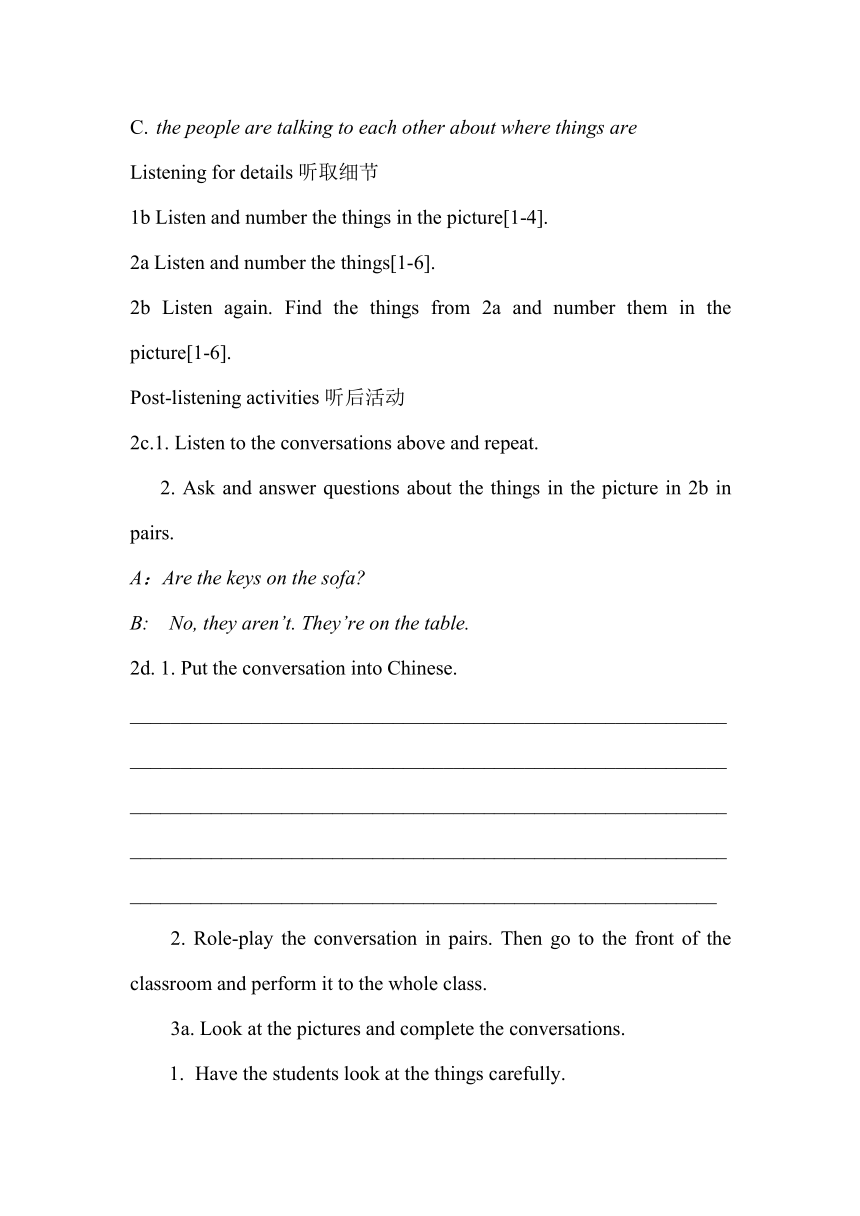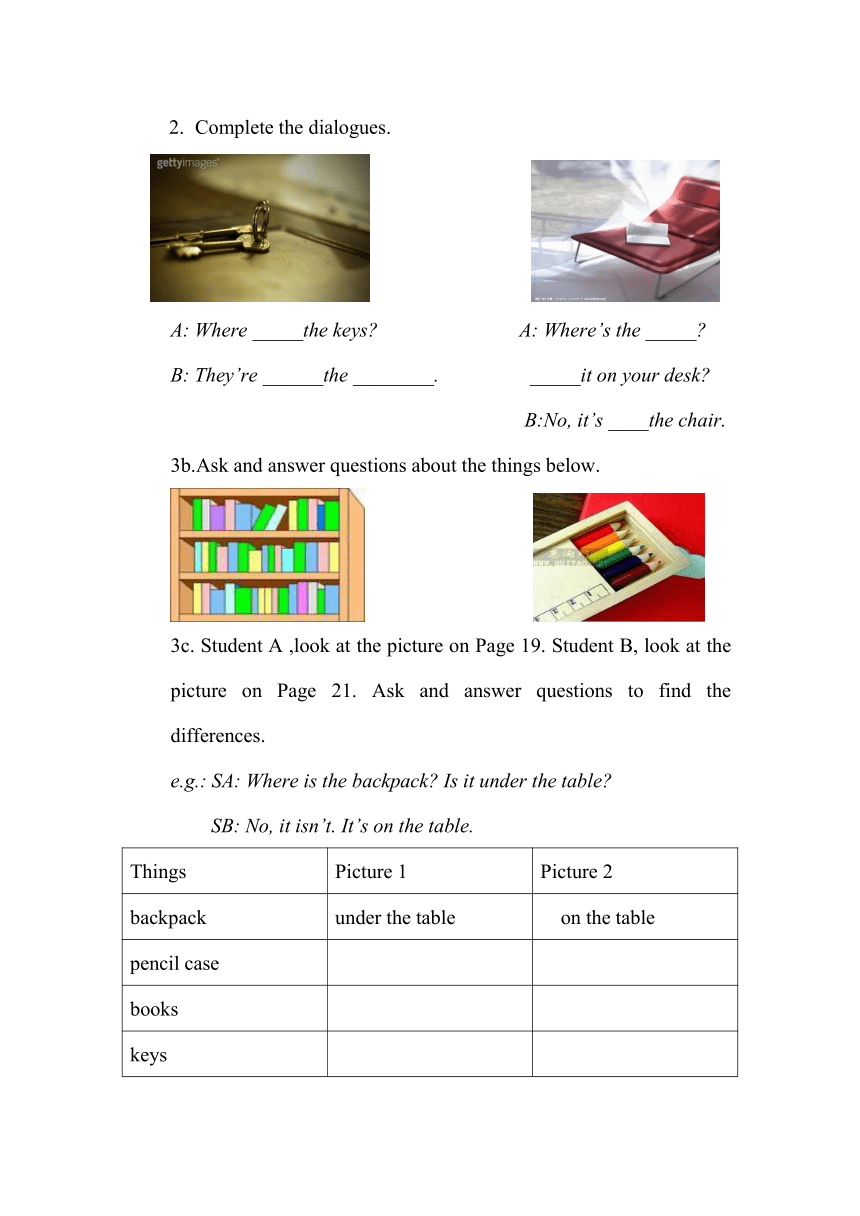Unit 4 Where’s my schoolbag?Section A(1a-3c)教学设计
文档属性
| 名称 | Unit 4 Where’s my schoolbag?Section A(1a-3c)教学设计 |  | |
| 格式 | zip | ||
| 文件大小 | 87.5KB | ||
| 资源类型 | 教案 | ||
| 版本资源 | 人教新目标(Go for it)版 | ||
| 科目 | 英语 | ||
| 更新时间 | 2012-12-23 16:22:33 | ||
图片预览




文档简介
单元题目 Unit4 Where’s my schoolbag?
Section A (1a-3c) Learning Goals
Talk about “ Things around the house ”and learn to inquiry “ the location of objects ” . Make Ss learn basic sentence patterns “ Where’s my backpack? It’s under the chair. ”Make Ss help each other in groups and cooperate actively with others to complete learning task. Help Ss set up long-range ideals.
Preview and testing
Read the book page by page and find the English for the following. Then close the book and write the English for them.
1.在书包里_________
2.在椅子下_________
3.在桌子上_________
4.---我的书在哪里?____________________________
---他们在沙发上。_____________________________
5.---我的铅笔盒在哪儿?________________________________
---他在你的书包里。__________________________________
6.---我的电脑游戏机在哪儿?_______________________________
---他在你的床下。_____________________________________
7.---钥匙在沙发上吗?__________________________________
---不,不在。它们在桌子上。______________________________ Warming up and leading in热身导入 Play an English song before class. Revise some school things by asking questions. e.g.: What’s this? Is this a …? How do you spell it? etc. Consolidate the prepositions by looking at the screen and answer the questions: Where’s … ? It’s…
Where’re…? They’re…
Play a game.
Look for things. The students hide and look for the things in groups. They can give the others some clues. For example: A: Where’s my pen ? B: It’s on the desk.
A: Where’re…? B: They are on/in/under the … (通过设置让学生找东西这样一个真实的场景来导入新课,能够立刻调动学生的参与性,激发学生思维,启动学习的发生。)
Listening for the general idea 听取大意 The main idea of the three conversations is that_______.
the people are talking to each other about themselves
the people are talking to each other about what things are
the people are talking to each other about where things are
Listening for details听取细节 1b Listen and number the things in the picture[1-4].
2a Listen and number the things[1-6].
2b Listen again. Find the things from 2a and number them in the picture[1-6].
Post-listening activities听后活动
2c.1. Listen to the conversations above and repeat.
2. Ask and answer questions about the things in the picture in 2b in pairs.
A:Are the keys on the sofa?
B: No, they aren’t. They’re on the table.
2d. 1. Put the conversation into Chinese.
______________________________________________________________________________________________________________________________________________________________________________________________________________________________________________________________________________________________________
2. Role-play the conversation in pairs. Then go to the front of the classroom and perform it to the whole class.
3a. Look at the pictures and complete the conversations.
Have the students look at the things carefully.
Complete the dialogues.
A: Where _____the keys? A: Where’s the _____?
B: They’re ______the ________. _____it on your desk?
B:No, it’s ____the chair.
3b.Ask and answer questions about the things below.
3c. Student A ,look at the picture on Page 19. Student B, look at the picture on Page 21. Ask and answer questions to find the differences.
e.g.: SA: Where is the backpack? Is it under the table? SB: No, it isn’t. It’s on the table.
Things
Picture 1
Picture 2
backpack
under the table
on the table
pencil case
books
keys
dog
Ask some students to report their answer like this: In Picture 1, the pencil case is … In Picture 2, the pencil case is…; In Picture 1, the books are … In Picture 2, the books are … (设置任务,通过对比的方式让学生理解方位介词。利用表格直观体现出两幅图的不同点, 再将它的不同点复述出来,其目的在于培养学生的语言组织能力。) Inquiry into knowledge by translation
一、Put Grammar Focus on P21 into Chinese in pairs.
_____________________________________________________________________________________________________________________________________________________________________________________________________________________________________________________________________________________________________________________________________________________________________________________________________________________________
二、观察并翻译下面的句子,体会本课语法。
1. Where’s the map?________________________________
2. It’s on the desk._______________________________
3. Where are the keys?______________________________
4. They are under the table.________________________
结论: “Where is/are …?”这一句型表示“____________________________”
回答时为了避免重复,用_______________来作为答语的主语,然后再加is和介词短语。
练习: 1. ---我的书在哪儿?---Where is my book?
---他在那儿。--- ________ is over there.
2. ---他的钥匙在哪儿?---Where are his keys?
--在书桌上。---________on the desk.
The-end-of-class test 当堂检测
一、根据句意和汉语提示完成句子。
1.The________(收音机)is under the desk.
2.—Where are my books?
—Let me________(想一想).
3.—Where’s the model plane?
—It’s________________(在…下面)the table.
二、单项选择
( )1.________ my baseball? It’s under the chair.
A.Where B.Where’s C.Where’re D.Where are
( )2.________ under the tree? No,they aren’t.
A.Where are B.What is C.Are they D.Is it
( )3.Where are your brothers? ________.
A.He is at home B.He is in his room
C.Yes,they are D.I don’t know、
( )4.________ there water in the cup?
A.Is B.Are C.Has D.Have
( )5.What’s under the desk? ________.
A.It’s a football B.I can see a set of keys
C.They are red box D.There’s a cat
三、 根据所给中文提示完成英语句子。 1. 我的棒球在哪儿?(where)
_____________________________________
2. 它在桌子的下面。(under)
____________________________________ 3. 我的书包和棒球在地板上。 My bag and baseball _____ _____ ______ ______. 4.---我的电脑游戏机在支架上吗?
---不,它在地板上。(on)
_______________________________________
_______________________________________
5. 手表在桌子上吗? ______ the watch _____ ______ _______?
教学反思:
本节课通过许多听力练习和句型教学,培养学生运用听关键词的技巧。同时也培养了学生的注意力。教师通过对不同事物在何方位的提问,将学生的注意力集中在不同的方位上,培养了学生的判断能力,勤于思考的习惯。在思考中遇到困难自我处理或向他人寻求帮助的习惯。
Section A (1a-3c) Learning Goals
Talk about “ Things around the house ”and learn to inquiry “ the location of objects ” . Make Ss learn basic sentence patterns “ Where’s my backpack? It’s under the chair. ”Make Ss help each other in groups and cooperate actively with others to complete learning task. Help Ss set up long-range ideals.
Preview and testing
Read the book page by page and find the English for the following. Then close the book and write the English for them.
1.在书包里_________
2.在椅子下_________
3.在桌子上_________
4.---我的书在哪里?____________________________
---他们在沙发上。_____________________________
5.---我的铅笔盒在哪儿?________________________________
---他在你的书包里。__________________________________
6.---我的电脑游戏机在哪儿?_______________________________
---他在你的床下。_____________________________________
7.---钥匙在沙发上吗?__________________________________
---不,不在。它们在桌子上。______________________________ Warming up and leading in热身导入 Play an English song before class. Revise some school things by asking questions. e.g.: What’s this? Is this a …? How do you spell it? etc. Consolidate the prepositions by looking at the screen and answer the questions: Where’s … ? It’s…
Where’re…? They’re…
Play a game.
Look for things. The students hide and look for the things in groups. They can give the others some clues. For example: A: Where’s my pen ? B: It’s on the desk.
A: Where’re…? B: They are on/in/under the … (通过设置让学生找东西这样一个真实的场景来导入新课,能够立刻调动学生的参与性,激发学生思维,启动学习的发生。)
Listening for the general idea 听取大意 The main idea of the three conversations is that_______.
the people are talking to each other about themselves
the people are talking to each other about what things are
the people are talking to each other about where things are
Listening for details听取细节 1b Listen and number the things in the picture[1-4].
2a Listen and number the things[1-6].
2b Listen again. Find the things from 2a and number them in the picture[1-6].
Post-listening activities听后活动
2c.1. Listen to the conversations above and repeat.
2. Ask and answer questions about the things in the picture in 2b in pairs.
A:Are the keys on the sofa?
B: No, they aren’t. They’re on the table.
2d. 1. Put the conversation into Chinese.
______________________________________________________________________________________________________________________________________________________________________________________________________________________________________________________________________________________________________
2. Role-play the conversation in pairs. Then go to the front of the classroom and perform it to the whole class.
3a. Look at the pictures and complete the conversations.
Have the students look at the things carefully.
Complete the dialogues.
A: Where _____the keys? A: Where’s the _____?
B: They’re ______the ________. _____it on your desk?
B:No, it’s ____the chair.
3b.Ask and answer questions about the things below.
3c. Student A ,look at the picture on Page 19. Student B, look at the picture on Page 21. Ask and answer questions to find the differences.
e.g.: SA: Where is the backpack? Is it under the table? SB: No, it isn’t. It’s on the table.
Things
Picture 1
Picture 2
backpack
under the table
on the table
pencil case
books
keys
dog
Ask some students to report their answer like this: In Picture 1, the pencil case is … In Picture 2, the pencil case is…; In Picture 1, the books are … In Picture 2, the books are … (设置任务,通过对比的方式让学生理解方位介词。利用表格直观体现出两幅图的不同点, 再将它的不同点复述出来,其目的在于培养学生的语言组织能力。) Inquiry into knowledge by translation
一、Put Grammar Focus on P21 into Chinese in pairs.
_____________________________________________________________________________________________________________________________________________________________________________________________________________________________________________________________________________________________________________________________________________________________________________________________________________________________
二、观察并翻译下面的句子,体会本课语法。
1. Where’s the map?________________________________
2. It’s on the desk._______________________________
3. Where are the keys?______________________________
4. They are under the table.________________________
结论: “Where is/are …?”这一句型表示“____________________________”
回答时为了避免重复,用_______________来作为答语的主语,然后再加is和介词短语。
练习: 1. ---我的书在哪儿?---Where is my book?
---他在那儿。--- ________ is over there.
2. ---他的钥匙在哪儿?---Where are his keys?
--在书桌上。---________on the desk.
The-end-of-class test 当堂检测
一、根据句意和汉语提示完成句子。
1.The________(收音机)is under the desk.
2.—Where are my books?
—Let me________(想一想).
3.—Where’s the model plane?
—It’s________________(在…下面)the table.
二、单项选择
( )1.________ my baseball? It’s under the chair.
A.Where B.Where’s C.Where’re D.Where are
( )2.________ under the tree? No,they aren’t.
A.Where are B.What is C.Are they D.Is it
( )3.Where are your brothers? ________.
A.He is at home B.He is in his room
C.Yes,they are D.I don’t know、
( )4.________ there water in the cup?
A.Is B.Are C.Has D.Have
( )5.What’s under the desk? ________.
A.It’s a football B.I can see a set of keys
C.They are red box D.There’s a cat
三、 根据所给中文提示完成英语句子。 1. 我的棒球在哪儿?(where)
_____________________________________
2. 它在桌子的下面。(under)
____________________________________ 3. 我的书包和棒球在地板上。 My bag and baseball _____ _____ ______ ______. 4.---我的电脑游戏机在支架上吗?
---不,它在地板上。(on)
_______________________________________
_______________________________________
5. 手表在桌子上吗? ______ the watch _____ ______ _______?
教学反思:
本节课通过许多听力练习和句型教学,培养学生运用听关键词的技巧。同时也培养了学生的注意力。教师通过对不同事物在何方位的提问,将学生的注意力集中在不同的方位上,培养了学生的判断能力,勤于思考的习惯。在思考中遇到困难自我处理或向他人寻求帮助的习惯。
同课章节目录
- starters 预备篇(2012秋审查)
- Unit 1 Good morning !
- Unit 2 What’s this in English?
- Unit 3 What color is it ?
- Unit 1 My name's Gina.
- Section A
- Section B
- Unit 2 This is my sister.
- Section A
- Section B
- Unit 3 Is this your pencil?
- Section A
- Section B
- Unit 4 Where's my schoolbag?
- Section A
- Section B
- Unit 5 Do you have a soccer ball?
- Section A
- Section B
- Unit 6 Do you like bananas?
- Section A
- Section B
- Unit 7 How much are these socks?
- Section A
- Section B
- Unit 8 When is your birthday?
- Section A
- Section B
- Unit 9 My favorite subject is science.
- Section A
- Section B
